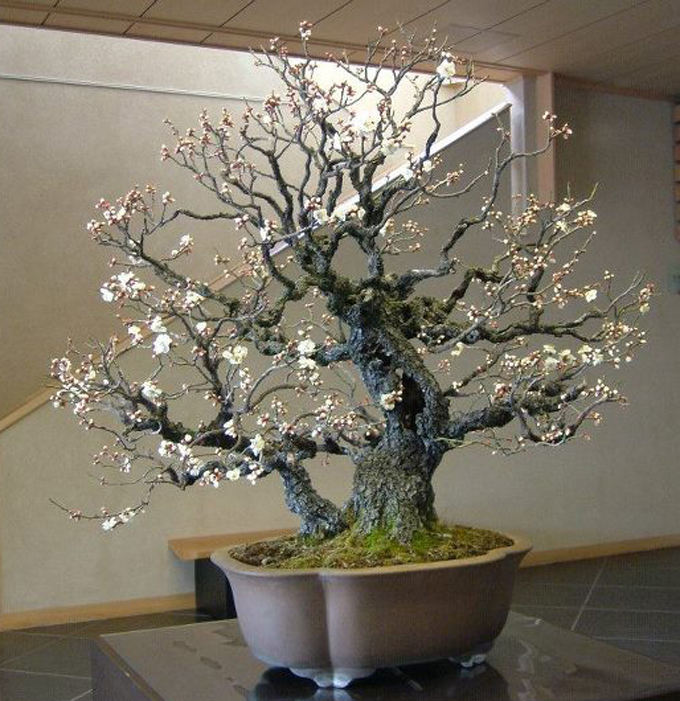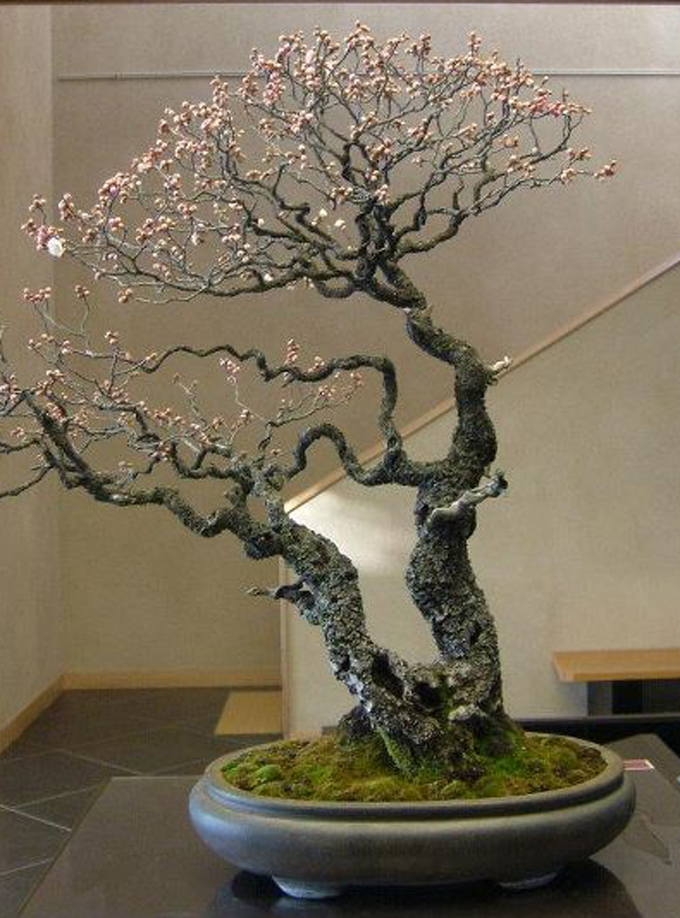 Sabamiki and uro. Aside from its overall power and beauty, there are a several things that might catch your eye: the flowers and buds, the aged bark (Ume bark develops an aged look fairly fast) and the hollowed out trunk (sabamiki). If you look closely you can also see several uro (small hollows that are left on deciduous trees where branches have rotted and fallen off, though bonsai uro may well be man made).
Sabamiki and uro. Aside from its overall power and beauty, there are a several things that might catch your eye: the flowers and buds, the aged bark (Ume bark develops an aged look fairly fast) and the hollowed out trunk (sabamiki). If you look closely you can also see several uro (small hollows that are left on deciduous trees where branches have rotted and fallen off, though bonsai uro may well be man made).
What’s in a name?
Ume have several names: Prunus mume (or just mume), Japanese apricot (or sometimes Japanese flowering apricot) and Chinese plum to name the most common. In the bonsai world, Ume seems to be the name of choice.
Fantastic bonsai
Ume is an Asian native and even though they make fantastic bonsai, for some reason not many nurseries grow them here in North America (Muranaka Nursery on the California central coast is one exception). As far as I know, they aren’t that difficult to grow as bonsai and they have numerous positive traits: they show the appearance of great age while still fairly young, they combine graceful elegance and tough looking ruggedness, and offer a striking display of buds and flowers late each winter. Altogether a noble candidate for your bonsai collection.
Omiya Bonsai Art Museum
The trees shown here reside at the Omiya Bonsai Art Museum in Saitama City, Japan. The photos are from Yoshitomo Ishizuka’s facebook page.
 Shari. Though it’s a little difficult to see, this ume features some deadwood (shari) on the trunk. You usually see deadwood on conifers, as it tends to rot fairly quickly on deciduous trees. However, on ume deadwood rots quite slowly, so the shari on this tree appears natural.
Shari. Though it’s a little difficult to see, this ume features some deadwood (shari) on the trunk. You usually see deadwood on conifers, as it tends to rot fairly quickly on deciduous trees. However, on ume deadwood rots quite slowly, so the shari on this tree appears natural.
 Fluid motion. Ume trunks and branches tend to display graceful, fluid motion. Just one more feature that makes Ume such a great subject for bonsai.
Fluid motion. Ume trunks and branches tend to display graceful, fluid motion. Just one more feature that makes Ume such a great subject for bonsai.
Most ume are zone 6 hardy, but where people have a problem is their susceptibility to fungal diseases in late winter and early spring. If one doesn’t have a good regimen for antifungals while overwintering, they’re going to be disappointed. Disappointment leads to disuse and the fostering the fallacy of ume being a “troublesome plant”. Quite a shame, too. If one has Prunus mume, Prunus incisa (Fuji cherry), and various Chaenomeles (speciosa or japonica) in their collection, there would be something flowering almost continually from late February or early March (in zone 6) through the normal blossom times for more common plants. Flowers that early are good for the soul after our long northeast winters!
Thanks Dave,
Good to know about the fungus. Do you know if liquid copper and/or lime sulfur are adequate to the task?
And agreed, early flowers are a great reward after a long winter.
Standard fungicides should be fine to ward off most problems. Just beware if you go for a second, late-winter application. If the flower buds are moving, just hold off rather than risk accidental damage to the buds.
Hi Dave,
The reason I asked about copper is that some fungicides are difficult to handle due to extreme toxicity. Back in my days at New England Bonsai we used liquid copper for almost all fungal infections with pretty good results. This is not to say the copper isn’t toxic to humans and other living things, just safer than many fungicides.